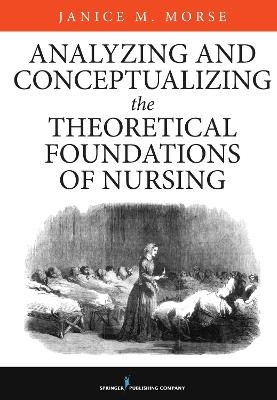
Analyzing and Conceptualizing the Theoretical Foundations of Nursing
Springer Publishing Co Inc (Verlag)
978-0-8261-6101-7 (ISBN)
Delivers all information required for the Theoretical Foundations of Nursing course
By embracing the major conceptual and theoretical contributions to nursing research that are outside of traditional nursing theory, this book serves as a vital resource for nurse researchers, and one that is indispensable for doctoral nursing students embarking on their dissertations. Containing the full complement of information required for the Theoretical Foundations of Nursing course for PhD programs, the text supports the foundational skills needed for excellence in research and scholarship. The book examines in depth the components of nursing theory and the types of theory used in nursing research and practice, and teaches students about the nature and use of concepts and the development of critical thinking skills that are essential for nursing research.
This text contains information for developing concepts and middle-range theory, using a variety of qualitative research methods, broadening theoretical scope by linking middle-range theories, and moving knowledge toward certainty by use of evidence. It also illustrates the construction of frameworks for quantitative inquiry, exploring theory in mixed-method design and how theory develops knowledge. Each method includes a description of the methodological approach and examples of subsequent concept or theory development. The text includes several methods for the development of concepts, micro- and mid-range theories using qualitative research, and a discussion of the new trend of moving these qualitative theories toward practice-based evidence. Each section of the book contains practical examples and supplementary activities that encourage inquiry. An instructor’s manual is included for adopters of the text.
Key Features:
Teaches the significance of and foundations of perspective, concepts, qualitatively derived theory, quantitative frameworks, quantitative theoretical development, knowledge development from research, application, and evidence
Focuses on current nursing research and how it is used in practice today
Demonstrates the significant relationship between theory, research, knowledge development, evidence, and practice
Promotes excellence in scholarship and research
Includes an extensive instructor’s manual
Janice M. Morse, PhD (Nurs), PhD (Anthro), FCAHS, FAAN, is a professor and Barnes Presidential Chair, College of Nursing, University of Utah, Salt Lake City, and professor emeritus, University of Alberta, Edmonton, Canada.
CONTENTS
Contributors
Preface
Acknowledgments
SECTION I: DESPERATELY SEEKING THEORY
1. The Fringes of Knowledge
Janice M. Morse
The Science of the Art
Exploring the Fringes: The Clinical Utility of Concept Inquiry
The Essentialness of Examining Our Practice
Why Do We Have to Know?
The Role of Values in Developing Knowledge
The Rise of Nursing Research and the Use of Frameworks and Models
2. Where We Came From
Janice M. Morse
Chasing Nursing Theory
The Need for Nursing Theory
The Need for Nurse Scientists
The Need for Nursing Concepts
Mid-Range and Situation-Specific Theories
The Need for Nurse Educators
The Performance and Products of Nurse Researchers
Nursing Theory for Directing Nursing Actions for Patient Care
The Gap Remains
Did We Forget?
Where Are We Now?
Where Are We Going?
3. Seeing What We Know: Knowing What We See
Laura Bohannan
Shakespeare in the Bush
4. Incorporating Theory Into Practice Research
Janice M. Morse
Scenario
Nursing Perspectives
Dialogue
Discussion
5. Orientation 101: Definitions and Other Essential Extraneous Notes
Janice M. Morse
Paradigm
6. The Battlefield of Knowledge: Different Purposes, Different Approaches
Janice M. Morse
Inductive Approaches to Concept Development
Deductive Approaches to Concept Development
Developing Quantitative Models and Theories
Abduction
The Complementary Relationship Between Qualitative and Quantitative Knowledge
Last Thoughts
SECTION II: ALL ABOUT CONCEPTS
The Conceptualization of Concepts
7. Concepts in Context
Janice M. Morse
What Is Context?
What Is a Concept?
Behavioral Concepts
The Structure of Concepts
The “Anatomy” of Concepts
Recontextualization
The “Physiology” of Concepts
Types of Concepts
Approaches to Understanding Concepts
The Contribution of Concepts
Frameworks and Models
Theory
Last Words
8. Summary of Major Methods for Exploring Concepts
Janice M. Morse
Philosophical Methods for Concept Analysis
Meta-Analytic Methods
Combined Methods: Methods Using the Literature and Qualitative Data
Methods Using Qualitative Inquiry
Summary
9. Inductive–Deductive Pitfalls in Concept Development
Janice M. Morse
The Myth of Induction
Exploring Qualitatively Derived Concepts: Inductive Techniques
Summary
10. The Pink Elephant Paradox (or, Avoiding the Misattribution of Data)
Judith A. Spiers
The Importance of Nurse–Patient Communication
The Concept of Vulnerability
Exploring Vulnerability in Home Care Nurse–Patient Interactions
Summary
11. Concept Evaluation: Determining Appropriate Strategies for Concept Development
Janice M. Morse
Determining Level of Maturity
The Process of Assessing Concepts
The Level of Maturity
SECTION III: EMERGING CONCEPTS
12. Qualitative Strategies for Concept Development
Janice M. Morse
Targeting Concepts Using Qualitative Inquiry
Building Lay Concepts Epistemologically
Qualitative Methods for Developing Concepts
A Mapping Method to Locate a Concept
Kristy K. Martyn
Qualitative Strategies for Identifying Concepts
Example of Interpretative Coding: Getting Behind the Data
Janice M. Morse, Kim Martz, and Terrie Vann-Ward
Analytic Strategies for Identifying Attributes
Qualitative Research Strategies for Expanding Concepts
Summary
13. Concept Identification Using Qualitative Inquiry
Janice M. Morse
Developing a Concept From Data: The Example of Compathy
Role of Compathy in Knowledge Development
14. Building Concepts
Janice M. Morse
Concept-Supporting Data
The Data–Concept Link
Developing Concepts to Using Studies to Support an Emerging Concept
Emerging Concepts
The Case of “Preserving Self”
Summary
15. Qualitative Structured Techniques
Janice M. Morse
Targeted Strategies for Concept and Attribute Development
Summary
16. The Prototypical Method
Janice M. Morse
The Prototypical Method
The Case of Hope
Summary
SECTION IV: PARTIALLY DEVELOPED CONCEPTS
17. Concept Clarification: The Use of Pragmatic Utility
Janice M. Morse
Procedures: Doing Pragmatic Utility
18. Research Using Pragmatic Utility
Janice M. Morse
Example I: Concept Clarification Inside a Concept: The Conceptualizations of Caring and Caring as a Concept
Comparing the Conceptualizations and Theories of Care
Discussion on Caring as a Concept
Example II: Concept Clarification: Accounting for Strategies of Empathetic Comforting
Summary: Back to Pragmatic Utility as a Method
19. Concept Comparison
Janice M. Morse
The Patterns and Uses of Concept Comparison
Allied Concepts
Concept Comparison as a Method
Patterns of Concept Comparison
The Example: The Conceptual Cohesion of Social Support
Judith E. Hupcey
Evaluating Concepts for Appropriate Application
The Example: Trust
Judith E. Hupcey
Recognizing When It Is Good: Criteria for Excellence in Concept Development
Hints for Getting It Right
“What About Reliability and Validity?”
Criterion for Adequacy
Summary
20. Self-Transcendence and Self-Reformulation: One Concept or Two?
Patricia L. Eldershaw and Janice M. Morse
Self-Transcendence
Self-Reformulation
Comparing the Concepts
Method
Results
Discussion
SECTION V: TOWARD MID-RANGE THEORY
21. From Concept Development to Qualitatively Derived Theory: Ethical Sensitivity in Professional Practice
Kathryn Weaver
Overview
Concept Analysis Using Pragmatic Utility
Explicating Concept Anatomy
Moving From Anatomy of the Concept to Its Physiology
Evaluating Concept Maturity
Advancing the Concept of Ethical Sensitivity Using Critical Appraisal
Toward Clearer Understanding of the Concept
Beyond Concept Analyses to Systematic Classification and Theory Construction
Summary
22. Linking and Ordering Concepts
Janice M. Morse
The Process of Qualitatively Developing Mid-Range Theories
Linking Concepts
Linking Concepts in the Process of Inquiry
Context Dependency and Linking Concepts
Determining Linkages Between Concepts
Ordering Concepts
Conceptual Development: The Maturity of the Theory
Other Techniques for Developing Concepts to Theory
Diagramming as a Tool
Qualitative Generalizability
The Last Thought
23. Making Useful Theory: Making Theory Useful
Janice M. Morse
Making Useful Theory
What Is Mid-Range Theory?
The Role of Theory
The Structure of Mid-Range Theories
Types of Qualitatively Derived Theory
The Process of Qualitatively Developing Mid-Range Theories
Processes of Theory Construction
The Structure of Mid-Range Theory
Setting Up Your Study to Develop Qualitatively Derived Theory
Developing Theory Using Conceptual Inquiry
Examples of Qualitatively Derived Mid-Range Theories
The Place of Concept Development: Understanding Its Contribution in Research Programs and Its Contribution to Knowledge and Praxis
Indices of Theoretical Adequacy
Toward Certainty
Rigor
The Place of Concept Development
Summary
24. Modes of Releasing in the Praxis Theory of Suffering: The Responses of Women to the Results of Breast Biopsy
Janice M. Morse and Charlotte Pooler
Literature
Methods
Results
Discussion
SECTION VI: MIXED- AND MULTIPLE-METHOD APPROACHES
25. Expanding Theory Using Mixed Methods
Janice M. Morse
Mixed-Method Approaches
Example of Qualitatively Driven Mixed-Method Design: Patterns of Attending
26. Developing Theory Using Mixed Methods: Patterns of Attending in Nursing
Joan L. Bottorff
The Study of Nurse–Patient Interactions
A Model of Nurse–Patient Interactions
Development of a Coding Scheme to Explore Patterns of NPI
Discussion
Summary
SECTION VII: THE QUANTITATIVE MINDFRAME
27. Developing Quantitative Theory
Janice M. Morse
The Role of Quantitative Theory
Creating Theoretical Frameworks
Evaluating the Literature
Identifying the Concepts
Operationalization
Planning Your Research Design
Building the Model
The Theoretical Framework
Examples of Models for Multivariate Research
Frameworks
Evaluating Quantitative Theory
Summary
28. The Social Determinants of Health: An Expanded Conceptual Framework for Nursing
Shirley M. Solberg
What Are the Social Determinants of Health?
Evolution of Social Determinants of Health
Beginning the Debate
The Social Determinants Identified
Models Used for Social Determinants of Health Framework
Assumptions and Principles of the Committee on the Social Determinants of Health Model
Evidence for Social Determinants of Health Framework
Research and the Social Determinants of Health
Strategies for Research and Policy Development on the SDH
Social Determinants of Health in Nursing: Possibilities
SECTION VIII: TOWARD CERTAINTY: BUILDING A MATURE THEORETICAL BASE
29. Toward Certainty: Qualitative Meta-Synthesis
Janice M. Morse
The Development of Meta-Synthesis
30. Meta-Synthesis of Nursing Presence
Deborah Finfgeld-Connett
Meta-Synthesis of Nursing Presence
Methodology
Findings
Discussion
Summary
31. Perceived Competency and Resolution of Homelessness Among Women With Substance Abuse Problems
Deborah Finfgeld-Connett, Tina L. Bloom, and E. Diane Johnson
Methodology
Findings
Provision of Services in the Context of Distorted Perceptions of Competency
Discussion
Summary
Funding
32. Developing Theory Using Meta-Analysis
Janice M. Morse
Meta-Analysis
Doing Meta-Analysis
Developing the Illness-Constellation Model
33. Toward a Theory of Illness: The Illness-Constellation Model
Janice M. Morse
Stage I: The Stage of Uncertainty
Stage II: Stage of Disruption
Stage III: Striving to Regain Self
Stage IV: Regaining Wellness
Discussion
Other Examples of Qualitative Meta-Analysis
SECTION IX: TOWARD THEORY-BASED INTERVENTIONS
34. Theoretical Coalescence
Janice M. Morse
The Limited Scope of Mid-Range Theory
35. The Evolution of Our Understanding of Suffering: The Praxis Theory of Suffering
Janice M. Morse
Background
The Physiology of the Model
36. Toward Understanding Comfort and Comforting
Janice M. Morse
Assumptions About Comfort and Comforting
Doing Theoretical Coalescence
Axioms
Summary
37. The Praxis Theory of Comfort and Comforting
Janice M. Morse
Contextual Factors Influencing Comfort and Comforting
The Praxis Theory of Comfort and Comforting
Nursing Approach
Attaining Comfort
The Comforting Interaction
The Interactive Components
The Complexity of Providing Comfort: The Comforting Relationship
Summary
38. The Theory of Becoming Resolute: Guiding Mental Health Practice With Survivors of Maltreatment
Joanne M. Hall
Marginalization as the Paradigm
Narrative and Theory
Research Underpinnings of the Theory of Becoming Resolute
Narrative Threads of Becoming Resolute
Supportive Threads
Central Dynamic Threads of Becoming Resolute
Clinically Relevant Findings
Discussion of the Study Findings
Narrative Threads and Conventional Concepts
Relationships Among Narrative Threads of Becoming Resolute
Becoming Resolute: From Theory to Practice
Clinical Principles Toward Becoming Resolute
The Story From Here
SECTION X: POSTFACE
39. The Myth of a Theory Base
Janice M. Morse
Dissemination or Dissipation?
The Problem of Dissemination
Summary
Postface: The (R)Evolution of Nursing
Index
| Erscheinungsdatum | 02.09.2016 |
|---|---|
| Verlagsort | New York |
| Sprache | englisch |
| Maße | 178 x 254 mm |
| Themenwelt | Pflege ► Fachpflege ► Anästhesie / Intensivmedizin |
| Pflege ► Studiengänge ► Pflegewissenschaft | |
| ISBN-10 | 0-8261-6101-4 / 0826161014 |
| ISBN-13 | 978-0-8261-6101-7 / 9780826161017 |
| Zustand | Neuware |
| Haben Sie eine Frage zum Produkt? |
aus dem Bereich


